I'm trying to model a certain flow using graphviz, and I can't figure out how to model the following graph to share the same horizontal center
digraph exmp {
A -> B -> C -> D
C -> E [constraint=false]
A -> C [style="dotted", constraint=false]
A -> D [style="dotted", constraint=false]
B -> D [constraint=false]
D -> A [style="dashed", constraint=false]
C -> A [style="dashed", constraint=false]
subgraph cluster_hackToSinkIt { E -> F }
{ rank="sink" E F }
}
this results in the following graph:

My question is, how can I get the E -> F to be positioned under D such that is lies in the same column?
